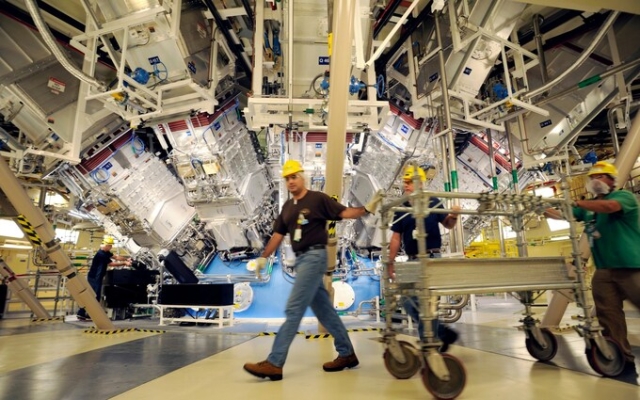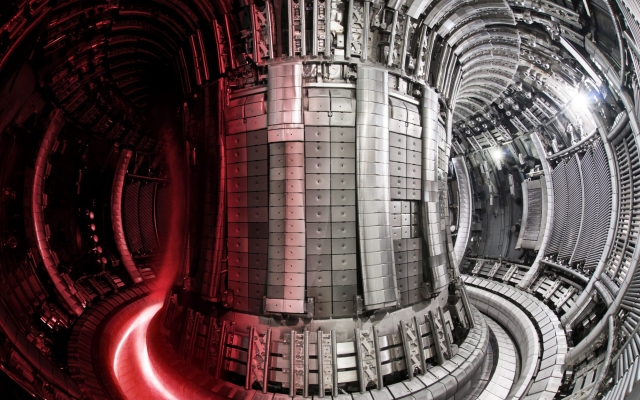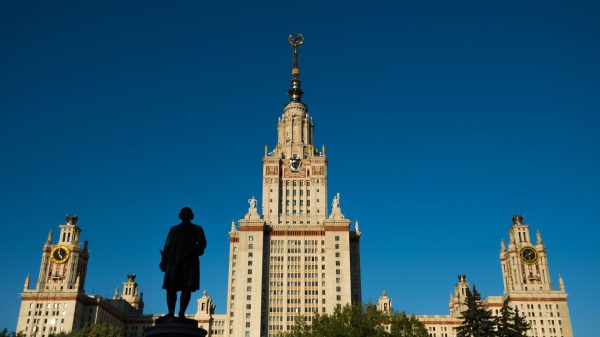 US efforts at Lawrence's Livermore Laboratory have repeatedly resulted in «burning» or a net increase in energy from nuclear fusion. Photo: David Butow/Corbis via Getty Images
US efforts at Lawrence's Livermore Laboratory have repeatedly resulted in «burning» or a net increase in energy from nuclear fusion. Photo: David Butow/Corbis via Getty Images
When Nick Hawker heard that American scientists had once again successfully produced energy by fusing two atoms, he immediately recognized the importance of it.
According to the founder and executive director of First Light Fusion, the successful experiment was «a real milestone in the field of physics.»
For the second time in seven months, the National Ignition Facility at Lawrence Livermore National Laboratory in California produced more power. energy from the fusion of two atoms than it took to start the reaction — a critical milestone.
The second experiment demonstrated that the breakthrough could be repeated. The promise of commercial nuclear fusion, the holy grail of clean energy, is closer.
But the breakthrough also showed how far the US is ahead, threatening to leave British startups like Oxford's First Light far behind.
National Ignition Center in Livermore, the lab that made the breakthrough, has received about $3.5 billion in funding from Washington.
By comparison, the UK's commitment to the Spherical Tokamak for Power Generation (STEP), the equivalent of a fusion lab, is only £220m. last year, provided $1.5 billion for green energy science, including fusion.
Although the UK developed a fusion strategy under Boris Johnson in 2021, it has fallen on the side of the road since he left Downing Street.
There are fears that the US is threatening to become a whirlpool for fusion funding, delaying global investment from other businesses in other parts of the world.
1312 Nuclear Fusion
Warrick Matthews, managing director of British company Tokamak Energy, says: “It may be easier to raise capital in the US than in the UK.”
British companies are now striving to demonstrate the effectiveness of their own synthesis. technologies in an attempt to attract investors while they still can.
If implemented at scale, nuclear fusion could be a decisive factor in the world's transition to clean energy. The only by-product of the reaction other than energy is harmless helium gas.
When deuterium and tritium are fused, two types of hydrogen with extra neutrons are heated to millions of degrees to the point where they fuse, releasing helium and a lot of energy.< /p>
The latest breakthrough in the US involves what is known as ignition, where fusion releases more energy than is used to drive the reaction. Lawrence in California managed to get even more power from the process in an experiment last month.
According to reports, about one kilowatt-hour was released during the reaction, which is enough to power the furnace for half an hour.
This is believed to be the fourth time American scientists have managed to ignite, raising the hope of connecting an energy source to the grid at a time when reliable, carbon-free energy has never been more in demand.
The US Department of Energy called it » a major scientific breakthrough that took decades.» this will pave the way for advances in national defense and a clean energy future.”
There are two broad approaches to launching fusion: one using magnets; and other firing lasers or projectiles known as inertial confinement.
The breakthrough at Lawrence Livermore National Laboratory occurred using the inertial confinement method.
First Light also uses this method. But Hawker warns that the lack of government and industry support means companies like his are fighting with one hand tied behind their backs.
“We have excellent academic achievements in the field of inertial fusion in this country. But we don't have a big facility, we don't have a big project, we don't have a coordinated effort,” he says.
Electricity Mix, UK
“All of our academic staff live in absolute shyness. I think more funding is needed for inertial fusion.”
The return on investment could be huge.
Hawker estimates that the world will need up to 10,000 fusion plants by 2050.
“How much clean energy will the world buy? From what I understand, the answer is to build as many as it is physically possible.”
First Light has developed a method for launching inertial fusion using a 22-meter gas cannon that fires a 100-gram cannon. a projectile with a speed of 6.5 km/s — about twenty times the speed of sound — on a pellet containing tritium and deuterium.
He wants to develop power plants that repeat the process every 30 seconds, with each pellet producing enough power. to power the average British home for more than two years.
Referring to an experiment at Lawrence Livermore National Laboratory, Hawker says: “The last step between our process and this one is exactly the same. So that gives us a huge, huge confidence that we are on the right track, because the core physics is exactly the same.”
First Light will soon build its own ignition demonstrator to show it to investors.
He wants to build an experimental power plant by the mid-2030s, and by the end of the next decade, a fully commercial power plant that will offer electricity for as little as $45 per megawatt-hour—about the same as its competitors.
But to take advantage of market opportunities, startups like him need continued support to advance the technology.
Investment in the UK fusion industry to date has largely focused on start-ups using an alternative method, magnetic fusion.
“I don’t think we should abandon magnetic fusion,” says Hawker. «But if [funding] is 100 to one at the moment, maybe we'll just add another nine, or another 20, or whatever, to even out.»
Tokamak Energy, which also based in Oxford, engaged in magnetic synthesis.
Managing director Matthews says: “Of course there is some competition. Our investors will want us to have some competition.»
A company backed by the US and UK governments has developed a device that last year hit 100 million degrees Celsius, the threshold for sustaining fusion.
>  British efforts in the global fusion race have been centered on the Joint European Torus project at the Culham Fusion Energy Center in Oxford. Matthews says.
British efforts in the global fusion race have been centered on the Joint European Torus project at the Culham Fusion Energy Center in Oxford. Matthews says.
However, Matthews says continued investment is critical to keeping the UK from falling behind international competitors.
“We all know it's easy to lose if you don't keep investing. ”
Scholars point to the massive amounts the US can invest in its early-stage research under the White House Inflation Reduction Act, as well as the vast resources of the Department of Energy, which had a $149 billion budget last year.
Developing this technology is not cheap.
“Merging is very difficult,” Matthews says. «When you even talk about driving a hot burning plasma, over 100 million degrees, most people understand that yes, it's quite difficult.»
And while recent breakthroughs in ignition in the US are of huge importance to the pursuit of commercial fusion, everyone agrees there are still many yards to go.
Hawker says, “It's like starting a fire, right? We've lit the kindling and now it's up to you to start the rest of the fire.»
A government spokesman said: «The UK is committed to becoming a world leader in the commercialization of fusion technology and we are investing more than £700 million in research programs and facilities in over the next three years.
«This is along with the British fusion strategy and regulatory framework that applies to all fusion technology approaches.»


























































Свежие комментарии